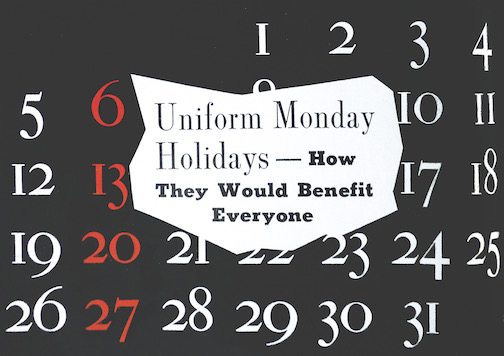The International Sleep Products Association’s first 100 years—Part III of the third installment
Uniform Monday Holiday Act brings sales, promotional opportunities
BY JULIE A. PALM
The mattress industry counts on three-day holiday weekends sprinkled throughout the year to juice its bottom line: The upcoming Labor Day period is one of the biggest annual sales generators for both retailers and manufacturers of mattresses and bedding. For those long weekends and the profits they bring, the industry has to thank the Uniform Monday Holiday Act, enacted by the U.S. Congress in 1968.
The law, which took effect in 1971, called for several federal holidays, including Washington’s Birthday (also called Presidents Day), Memorial Day and Columbus Day, to be celebrated on Mondays. Labor Day already was a Monday holiday—one pointed to as a model by supporters of the legislation.

The U.S. Congress passed the Uniform Monday Holiday Act in 1968 to establish the observance of certain holidays on Mondays. Its unintentional consequence was three-day holiday weekends that bolster bedding sales.
The National Chamber (now the U.S. Chamber of Commerce) led the drive to shift the number of midweek holidays as an effort to improve productivity and reduce absenteeism among employees. The idea was supported by a host of trade groups, including the National Association of Bedding Manufacturers. Monday holidays also were promoted as a way to benefit workers by giving them a three-day weekend for, as Bedding magazine noted in November 1967, “rest and relaxation, for travel, sports, hobbies, even do-it-yourself chores.”
Interestingly, a National Chamber survey taken in 1967 showed only 35% of businesses expected Monday holidays would lead to improved sales. In fact, NABM, though interested in the possibility of increased retail sales, was most excited about how three-day weekends would boost travel—and create markets for new beds at the motels and hotels where people would vacation. ✦
Read all seven parts of this month’s special ISPA 1966-1990 centennial section:
Part I – Main feature: ‘The challenge of change’
Part II – New directions for mattress industry public relations
Part III – Uniform Monday Holiday Act brings sales, promotional opportunities
Part IV – The industry enters the computer age
Part V – The Sealy wars erupt: Sealy Inc., Ohio-Sealy duke it out
Part VI – Out with the old: Industry works to keep used mattresses out of circulation
Part VII – Product trends of the time: Waterbeds make waves
View this special section as it appears in the print magazine: BedTimes’ August digital edition.
Read previous chapters in the 100-year history of ISPA:
1915-1940: An industry comes together
1941-1965: A time of war, a time for peace




